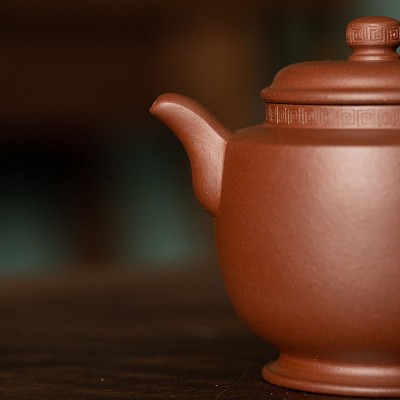







The design of the Palace Lamp "Gongdeng" in the Yongzheng period of the Qing Dynasty. Its prototype was a lantern, designed by an old man from Tuntou Village. Later, the Tuntou Lantern was presented as a tribute to a county-level official who took it to the palace. The Tuntou Lantern was named "Gongdeng" and became an exclusive item for the imperial palace. Later, people replaced the character "Gong" with "Palace," and it became the "Palace Lamp" we know today. The Palace Lamp teapot is designed based on this lantern, often appearing in a square shape with a fresh, natural, and elegant style that is in line with the aesthetic views of ancient people and easily accepted by modern people.
 Delivery
Delivery
Free shipping within 1 to 3 days. ETA:5-7 days
 Returns
Returns
Within 28 days after delivery date.
 Security
Security
SSL | GDRP used to ensure information security.
Guarantee safe & secure checkout
Data sheet
This Yixing Teapot is truly exquisite. The craftsmanship is outstanding, and it brews the most flavorful tea. It has become a cherished piece in my tea collection.
The design of the Palace Lamp "Gongdeng" in the Yongzheng period of the Qing Dynasty. Its prototype was a lantern, designed by an old man from Tuntou Village. Later, the Tuntou Lantern was presented as a tribute to a county-level official who took it to the palace. The Tuntou Lantern was named "Gongdeng" and became an exclusive item for the imperial palace. Later, people replaced the character "Gong" with "Palace," and it became the "Palace Lamp" we know today. The Palace Lamp teapot is designed based on this lantern, often appearing in a square shape with a fresh, natural, and elegant style that is in line with the aesthetic views of ancient people and easily accepted by modern people.
The design of the Palace Lamp "Gongdeng" in the Yongzheng period of the Qing Dynasty. Its prototype was a lantern, designed by an old man from Tuntou Village. Later, the Tuntou Lantern was presented as a tribute to a county-level official who took it to the palace. The Tuntou Lantern was named "Gongdeng" and became an exclusive item for the imperial palace. Later, people replaced the character "Gong" with "Palace," and it became the "Palace Lamp" we know today. The Palace Lamp teapot is designed based on this lantern, often appearing in a square shape with a fresh, natural, and elegant style that is in line with the aesthetic views of ancient people and easily accepted by modern people.
The apple-shaped Yixing teapot is another unique example of zisha teapot. As the name suggests, it is designed to resemble an apple.
Gourd yixing teapot features a unique design. The shape resembles a gourd, with a short and slightly upward-curved spout and a half-circular handle. The lid is decorated with a loop-shaped knob. The overall design is characterized by smooth and rounded lines.
"Yuhualong" is a classic yixing teapot shape, meaning "fish leaping over the dragon gate". The small fish-turned-dragon teapot knob made by Tang Shuzhi in the Republic of China is in the shape of rolling clouds, and the pot body is shallowly sculpted with waves. The dragon head protrudes from the waves, and the dragon tail curls into the handle, with clear scales carved on the handle. In the Qing Dynasty, Shao Daxiang's fish-turned-dragon was sculpted in layers of waves, with a strong three-dimensional sense, and the dragon head was short and thick, hidden in the lid without showing its claws. The knob was in the shape of stacked waves. Placing this teapot in the office or at home symbolizes good luck in all things, promotion in work, or academic advancement for students.
The design of the Palace Lamp "Gongdeng" in the Yongzheng period of the Qing Dynasty. Its prototype was a lantern, designed by an old man from Tuntou Village. Later, the Tuntou Lantern was presented as a tribute to a county-level official who took it to the palace. The Tuntou Lantern was named "Gongdeng" and became an exclusive item for the imperial palace. Later, people replaced the character "Gong" with "Palace," and it became the "Palace Lamp" we know today. The Palace Lamp teapot is designed based on this lantern, often appearing in a square shape with a fresh, natural, and elegant style that is in line with the aesthetic views of ancient people and easily accepted by modern people.
Pear-shaped yixing teapot,it is one of the pot styles that originated in the Chian Yuan Dynasty and became popular during the China Ming Dynasty. It is named after its pear-like shape.
The "Longdan" Yixing teapot, also known as the Dragon Ball Teapot, has an oval shape with a flat bottom and a smaller top, resembling an egg. It is crafted using traditional handmade techniques, with intricate carvings and fine texture that result in a deep and rich color. This teapot has excellent heat preservation and enhances the aftertaste of tea, making it suitable for brewing various types of tea. It is both elegant and practical, making it a highly sought-after Zisha teapot.
The eggplant-shaped Yixing teapot is a classic example of the zisha teapot. It is characterized by its unique shape, which resembles an eggplant, and is made of purple clay, also known as zisha clay.
"Zhugu" zisha teapot,taking bamboo as its theme, this teapot exaggerates and transforms its form, with the body sculpted into a trunk and the bamboo joints simplified and elegant, exuding a sense of stability and balance. The spout and handle are crafted into new tender branches, with a dynamic and powerful momentum. The lid is topped with a sculpted, curved bamboo twig in the shape of a bridge, with bamboo leaf patterns attached beneath the knob. This work perfectly captures the unique characteristics and noble qualities of bamboo, and the Bamboo Drum teapot has a unique place among yixing teapots due to its distinctive design.
Pear-shaped yixing teapot,it is one of the pot styles that originated in the Chian Yuan Dynasty and became popular during the China Ming Dynasty. It is named after its pear-like shape.
"Lianzi" means Lotus Seed, "lianzi" family has various shapes and forms, which reflects the Buddhist saying "Lotus originates from the heart, and the heart gives rise to infinite forms." the shape of the Lotus Seed was characterized by a straight mouth, drooping shoulders, circular feet, and a round and bulging body with a slightly bulging cover, resembling a lotus seed. Over time, the design evolved from being simple and rustic to being elegant and graceful, with the lid raised and adorned with a bead knob, making it look more towering. A small spout gracefully protrudes from the shoulder of the pot, while the handle is shaped like a woman's arm in a graceful and elegant stance.
The Melon-shaped Yixing teapot is a classic example of the zisha teapot. It is characterized by its unique shape, which resembles some melon , and is made of purple clay, also known as zisha clay.
The "Persimmon" is a type of teapot that was created by many teapot makers during the late Qing Dynasty and early Republic of China period. It is one of the most representative shapes of biomimetic and pictorial flower pots in purple sand pottery. The Persimmon teapot was a popular style during the late Qing and early Republic of China period. The teapot's belly is shaped like a round persimmon with four lobes, full and plump, symbolizing abundance and good luck in all things. The pot lid is integrated with the persimmon leaf pattern, vivid and lifelike. Because "persimmon" sounds like "matters" in Chinese, the Persimmon teapot is inspired by the persimmon fruit, with a lively and vivid design, symbolizing good luck and good fortune in all things.
NOTICE : Cookies ensure the smooth running of our services and improve user experience,Using these, you accept the use of cookies. Learn More.